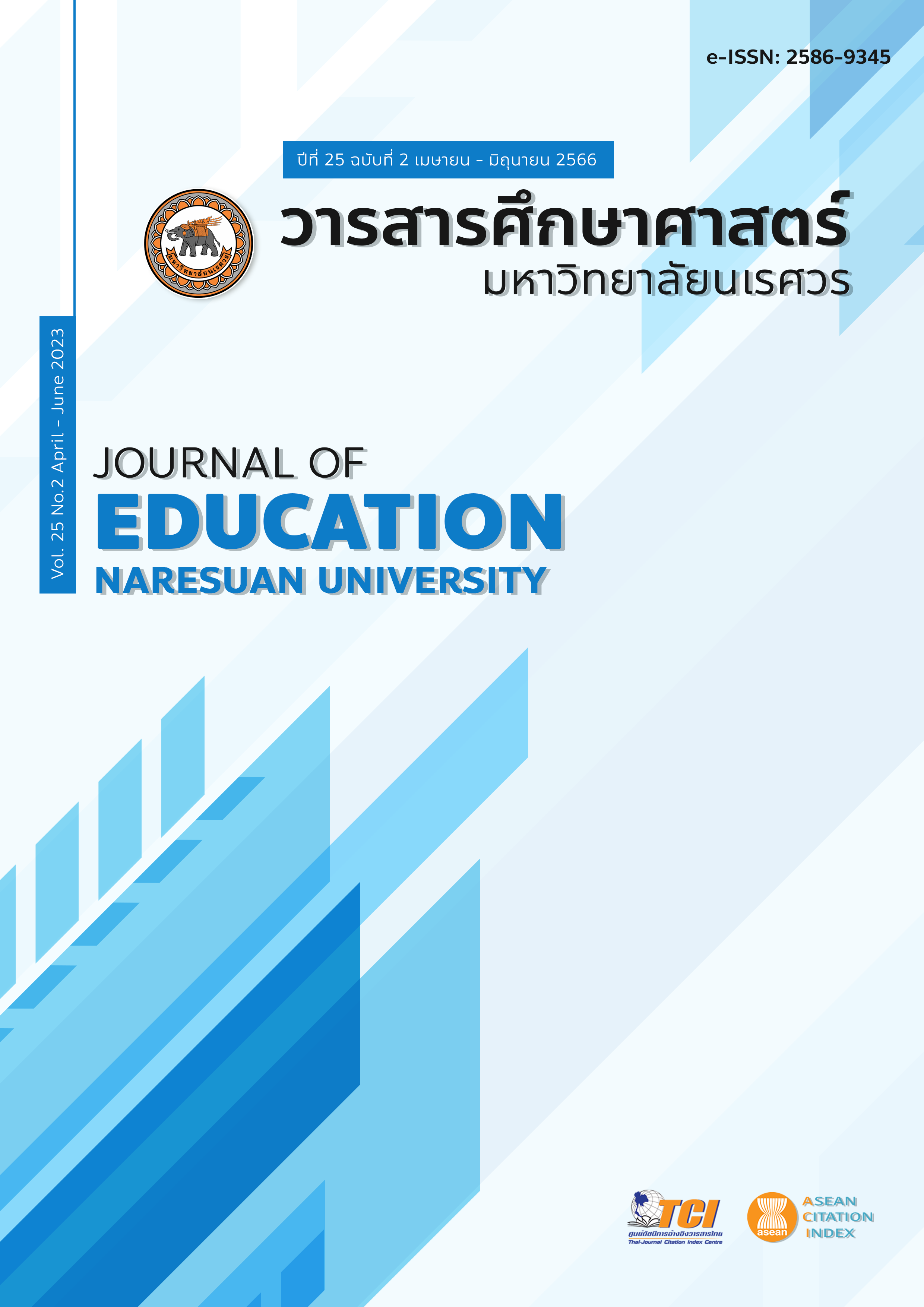NEEDS OF SECONDARY SCHOOL DEVELOPMENT FOR TEACHING EFFECTIVENESS BASED ON THE CONCEPT OF STUDENT GROWTH
Main Article Content
Abstract
This study sought to investigate the needs of secondary school development for teaching effectiveness based on the concept of student growth. Therefore, it aims to 1) study the level of needs for teaching effectiveness development methods and 2) identify the needs level of secondary school development for teaching effectiveness based on the concept of student growth. 516 teachers were participated, and a set of validated questionnaires were used to explore the needs for teaching effectiveness based on the concept of student growth. The study revealed that 1) the highest level of needs for the methods of teaching effectiveness development was “mentoring” followed by “training”, “coaching”, and “supervision and evaluation” and 2) the needs level of secondary school development for teaching effectiveness based on the concept of student growth was “mentoring” intending to “executing an effective classroom”, followed by “encouraging a desirable classroom environment” teaching effectiveness.
Article Details

This work is licensed under a Creative Commons Attribution-NonCommercial-NoDerivatives 4.0 International License.
The owner of the article does not copy or violate any of its copyright. If any copyright infringement occurs or prosecution, in any case, the Editorial Board is not involved in all the rights to the owner of the article to be performed.
References
Afe, J. (2003). Teacher effectiveness: Imperative for implementing universal basic education in Nigeria. Journal of Nigeria Academy of Education, 1(1), 1-9.
Anderman, E. M., & Young, A. J. (1994). Motivation and strategy use in science: Individual differences and classroom effects. Journal of research in science teaching, 31(8), 811-831.
Anderson, L. (2004). Increasing teacher effectiveness. Francia: UNESCO International Institute for Educational Planning.
Barry, R. (2010). Teaching effectiveness: Why it matters. Marylhurst, OR: Marylhurst University.
Betebenner, D. W., & Linn, R. L. (2010). Growth in student achievement: Issues of measurement, longitudinal data analysis, and accountability. Retrieved from http://www.k12center.org/publications.html
Blazar, D., & Kraft, M. A. (2017). Teacher and teaching effects on students’ attitudes and behaviors. Educational Evaluation and Policy Analysis, 39(1), 146-170.
Castellano, K. E., & Ho, A. D. (2013). A practitioner's guide to growth models. Washington, DC: Council of Chief State School Offi cers.
Choosuwan, R., & Vanitsuppavong, P. (2007). A causal relationship model of personal competency affecting effectiveness of educational service area office in the three southern border provinces (Doctoral dissertation). Pattanee: Prince of Songkla University.
Darling-Hammond, L., Hyler, M. E., & Gardner, M. (2017). Effective teacher professional development. Palo Alto, CA: Learning Policy Institute.
Dash, U., & Barman, P. (2016). Teaching effectiveness of secondary school teachers in the district of purba medinipur, west bengal. IOSR Journal of Humanities and Social Science, 21(7), 50-63.
Farrington, C. A., Roderick, M., Allensworth, E., Nagaoka, J., Keyes, T. S., Johnson, D. W., & Beechum, N. O. (2012). Teaching adolescents to become learners. The role of noncognitive factors in shaping school performance: A critical literature review. Chicago: University of Chicago Consortium on Chicago School Research.
Gutman, L. M., & Schoon, I. (2013). The impact of non-cognitive skills on outcomes for young people (pp. 1-5). London: Education Endowment Foundation. Leading Education and Social Research.
Howard, M. (2013). Using student growth data to improve teaching and learning. Retrieved from https://www.sdpbc.org/
Hull, J. (2007). Measuring student growth: A guide to informed decision making. Alexandria, VA: Center for Public Education.
Jennings, J. L., & DiPrete, T. A. (2010). Teacher effects on cultural capital development in elementary school. Sociology of Education, 83, 135-159.
Ko, J., & Sammons, P. (2013). Effective Teaching: A Review of Research and Evidence. ERIC.
Lachlan-Haché, L., & Castro, M. (2015). Proficiency or growth? An exploration of two approaches for writing student learning targets. Washington, DC: American Institutes for Research.
Leininger, D. (2019). Assessing teacher practice and effect on student growth mindset and grit (Doctoral dissertation). Terre Haute, IN: Indiana State University.
MOE. (2020). The Basic Education Core Curriculum B.E. 2551 (A.D. 2008)
Narintarangkul Na Ayudhaya, S. (2018). Paradigm, model and mechanism for area-based teacher development. Educational Management and Innovation Journal, 1(3), 82-100.
No Child Left Behind. (2002). Act of 2001, Pub. L. No. 107-110, § 115. Stat, 1425(6).
OBEC. (2019). Handbook of educational offce area; Supervision Monitoring and Evaluation for Educational Provision Group.
Ogunyemi, A. O. (2000). Concepts in teaching and learning methods teaching effectiveness in Nigeria schools edited by S.Y Erinosho, A. Adesanya and A. Ogunyemi.
Olsen, J. R. (2015). Illinois teacher evaluation student growth component: A predecision-making policy analysis. Normal, IL: Illinois State University.
ONEC. (2018). Education in Thailand 2018. Bangkok: Office of the Education Council
Oyedeji, N. B. (2019). Management in education: Principles and practice. London: LAP LAMBERT Academic Publishing.
Ruzek, E. A., Domina, T., Conley, A. M., Duncan, G. J., & Karabenick, S. A. (2015). Using value-added models to measure teacher effects on students’ motivation and achievement. The Journal of Early Adolescence, 35(5-6), 852–882. https://doi.org/10.1177/0272431614525260
Sammons, P., & Bakkum, L. (2011). Effective schools, equity and teacher efficacy: A review of the literature. Profesorado, revista de curriculum y formacion del profesorado, 15(3), 9-26.
Texas Education Agency. (2017). Guidance on student growth in T-TESS. Retrieved from https://teachfortexas.org/Resource_Files/Additional_Resources/Guidance_on_Student_Growth_in_T-TESS.pdf
Tripod Education Partners. (2017). The tripod 7Cs of effective teaching an overview. Retrieved from https://static.battelleforkids.org/documents/Tulsa/Tripod-Student-Survey-7C-Overview.pdf
Walsh, E., & Isenberg, E. (2015). How does value added compare to student growth percentiles? Statistics and Public Policy, 2(1), 1-13.
Wongwanich, S. (2015). Needs assessment research (3rd ed.). Bangkok: Chulalongkorn University Press.
Yamane, T. (1976). Statistics: An introductory analysis (2nd ed.). New York: Harper and Row Publications.


